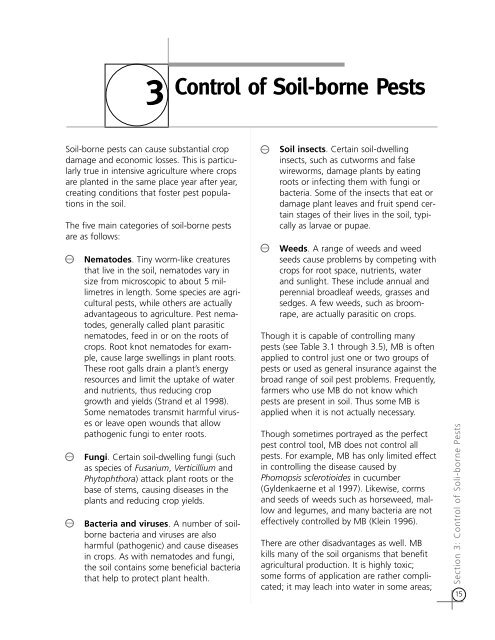Alternatives to Methyl Bromide - DTIE
Alternatives to Methyl Bromide - DTIE
Alternatives to Methyl Bromide - DTIE
You also want an ePaper? Increase the reach of your titles
YUMPU automatically turns print PDFs into web optimized ePapers that Google loves.
3 Control of Soil-borne Pests<br />
Soil-borne pests can cause substantial crop<br />
damage and economic losses. This is particularly<br />
true in intensive agriculture where crops<br />
are planted in the same place year after year,<br />
creating conditions that foster pest populations<br />
in the soil.<br />
The five main categories of soil-borne pests<br />
are as follows:<br />
Nema<strong>to</strong>des. Tiny worm-like creatures<br />
that live in the soil, nema<strong>to</strong>des vary in<br />
size from microscopic <strong>to</strong> about 5 millimetres<br />
in length. Some species are agricultural<br />
pests, while others are actually<br />
advantageous <strong>to</strong> agriculture. Pest nema<strong>to</strong>des,<br />
generally called plant parasitic<br />
nema<strong>to</strong>des, feed in or on the roots of<br />
crops. Root knot nema<strong>to</strong>des for example,<br />
cause large swellings in plant roots.<br />
These root galls drain a plant’s energy<br />
resources and limit the uptake of water<br />
and nutrients, thus reducing crop<br />
growth and yields (Strand et al 1998).<br />
Some nema<strong>to</strong>des transmit harmful viruses<br />
or leave open wounds that allow<br />
pathogenic fungi <strong>to</strong> enter roots.<br />
Fungi. Certain soil-dwelling fungi (such<br />
as species of Fusarium, Verticillium and<br />
Phy<strong>to</strong>phthora) attack plant roots or the<br />
base of stems, causing diseases in the<br />
plants and reducing crop yields.<br />
Bacteria and viruses. A number of soilborne<br />
bacteria and viruses are also<br />
harmful (pathogenic) and cause diseases<br />
in crops. As with nema<strong>to</strong>des and fungi,<br />
the soil contains some beneficial bacteria<br />
that help <strong>to</strong> protect plant health.<br />
Soil insects. Certain soil-dwelling<br />
insects, such as cutworms and false<br />
wireworms, damage plants by eating<br />
roots or infecting them with fungi or<br />
bacteria. Some of the insects that eat or<br />
damage plant leaves and fruit spend certain<br />
stages of their lives in the soil, typically<br />
as larvae or pupae.<br />
Weeds. A range of weeds and weed<br />
seeds cause problems by competing with<br />
crops for root space, nutrients, water<br />
and sunlight. These include annual and<br />
perennial broadleaf weeds, grasses and<br />
sedges. A few weeds, such as broomrape,<br />
are actually parasitic on crops.<br />
Though it is capable of controlling many<br />
pests (see Table 3.1 through 3.5), MB is often<br />
applied <strong>to</strong> control just one or two groups of<br />
pests or used as general insurance against the<br />
broad range of soil pest problems. Frequently,<br />
farmers who use MB do not know which<br />
pests are present in soil. Thus some MB is<br />
applied when it is not actually necessary.<br />
Though sometimes portrayed as the perfect<br />
pest control <strong>to</strong>ol, MB does not control all<br />
pests. For example, MB has only limited effect<br />
in controlling the disease caused by<br />
Phomopsis sclerotioides in cucumber<br />
(Gyldenkaerne et al 1997). Likewise, corms<br />
and seeds of weeds such as horseweed, mallow<br />
and legumes, and many bacteria are not<br />
effectively controlled by MB (Klein 1996).<br />
There are other disadvantages as well. MB<br />
kills many of the soil organisms that benefit<br />
agricultural production. It is highly <strong>to</strong>xic;<br />
some forms of application are rather complicated;<br />
it may leach in<strong>to</strong> water in some areas;<br />
Section 3: Control of Soli-borne Pests<br />
15
















